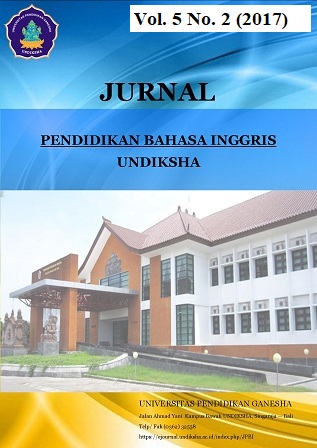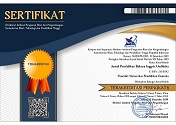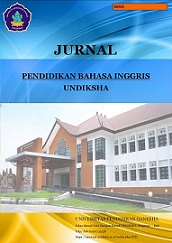THE PHONOLOGICAL AND LEXICAL CHANGES FROM LEMUKIH DIALECT TO GALUNGAN DIALECT
DOI:
https://doi.org/10.23887/jpbi.v5i2.11183Abstract
Penelitian ini bertujuan untuk mendeskripsikan perubahan fonologi dan leksikal dari dialek Lemukih ke dialect Galungan. Penelitian ini adalah penelitian deskriptif kualitatif. Terdapat tiga informan yang dipilih di Desa Lemukih dan Desa Galungan. Satu informan ditentukan sebagai informan utama dan dua informant lainnya ditentukan sebagai informan tambahan. Data yang dikumpulkan berdasarkan empat teknik diantaranya: Peneliti, observasi, rekaman, dan daftar kata (wordlist). Terdapat 462 kata di Budasi wordlist dan 208 kata Swadesh wordlist yang di peroleh sebagai data penelitian. Hasil dari data analisis menunjukkan bahwa terdapat sembilan kata yang dikategorikan sebagai penghilangan phoneme di awal kata (aphaeresis), 11 kata yang dikategorikan sebagai penghilangan phoneme di tengah kata ( syncope), enam kata yang dikategorikan sebagai penghilangan phoneme di akhir kata (apocope) dan enam kata dikategorikan sebagai penghilangan dua silabel dalam kata (haplology). Perubahan leksikal yang terjadi dari dialek Lemukih ke dialect Galungan diantaranya : 15 kata dikategorikan sebagai peminjaman kata dari bahasa Indonesia (borrowing words), delapan kata termasuk dalam kategori penghilangan kata and kompresi kata yang terdiri dari empat kata dikategorikan sebagai blend dan empat kata termasuk abbreviation.Kata Kunci : Dialek, Perubahan Fonologi, Perubahan Leksikal.
This study aimed at describing the phonological and lexical changes from Lemukih to Galungan dialect. This research was a descriptive qualitative research. There were three informants selected in each dialect. In this case, one important sample was determined as the main informant and the other two were determined as the secondary informant. The obtained data were collected based on four techniques, namely: the researcher, observation, recording, and wordlist. There were 462 words in Budasi and 208 words in Swadesh wordlists that were obtained as the data of the study. The result of the data analysis showed that there were nine words were categorized as deletion of the phoneme in the beginning of the word (aphaeresis), 11 words were categorized as deletion of the phoneme in the middle of word (syncope), six words were categorized as deletion of the phoneme in the final of the word (apocope) and six words were categorized as haplology. The lexical changes occur from Lemukih and Galungan dialect categorized as follows: 15 words belonging to loan or borrowing words, eight words belong to loss words, and compression which included four words belonging to word mixes and four words belonging to initials.
keyword : Dialect, Phonological changes, Lexical changes
Published
2017-07-25
Issue
Section
Articles
License
Authors who publish with the Jurnal Pendidikan Bahasa Inggris Undiksha agree to the following terms:- Authors retain copyright and grant the journal the right of first publication with the work simultaneously licensed under a Creative Commons Attribution License (CC BY-SA 4.0) that allows others to share the work with an acknowledgment of the work's authorship and initial publication in this journal
- Authors are able to enter into separate, additional contractual arrangements for the non-exclusive distribution of the journal's published version of the work (e.g., post it to an institutional repository or publish it in a book), with an acknowledgment of its initial publication in this journal.
- Authors are permitted and encouraged to post their work online (e.g., in institutional repositories or on their website) prior to and during the submission process, as it can lead to productive exchanges, as well as earlier and greater citation of published work. (See The Effect of Open Access)













